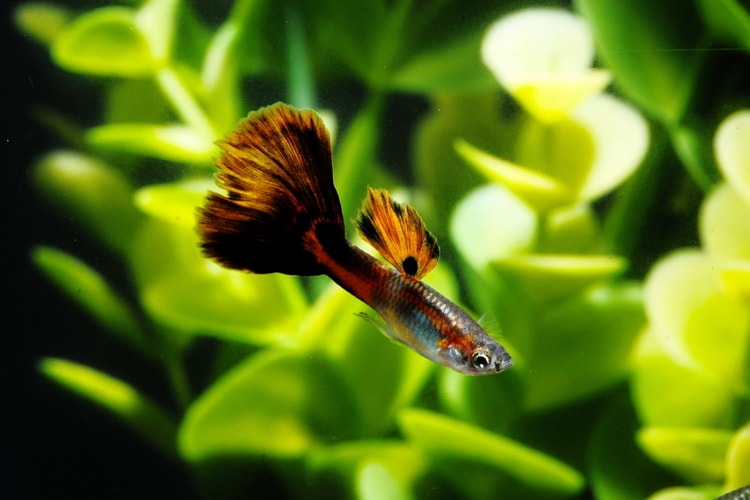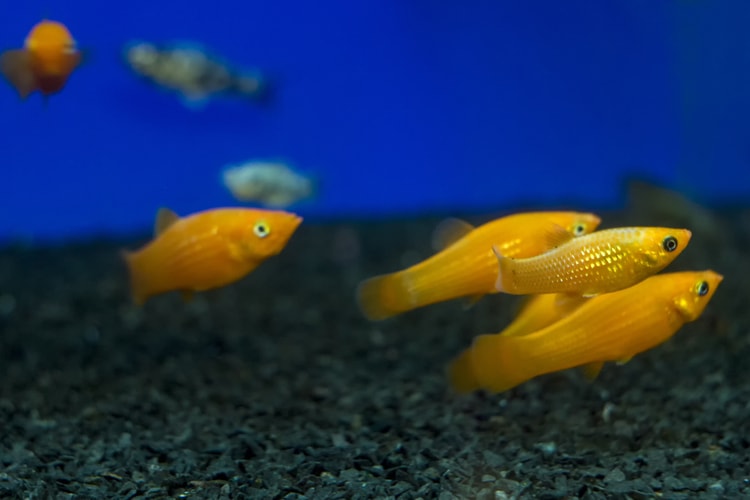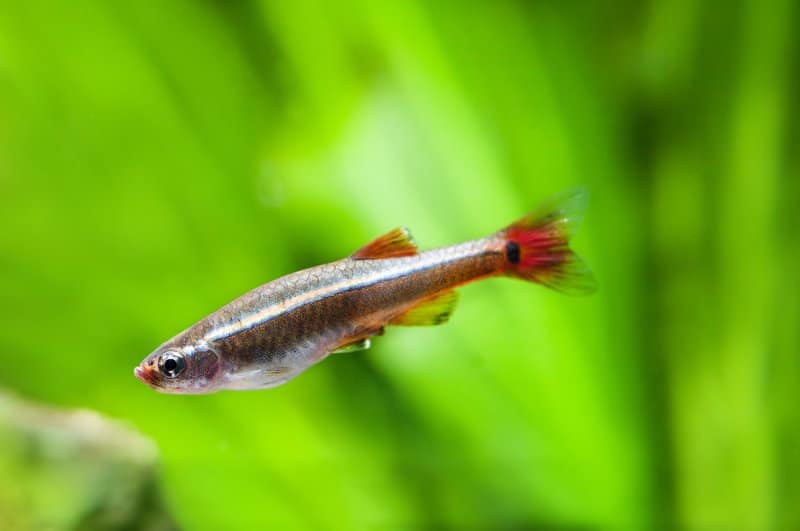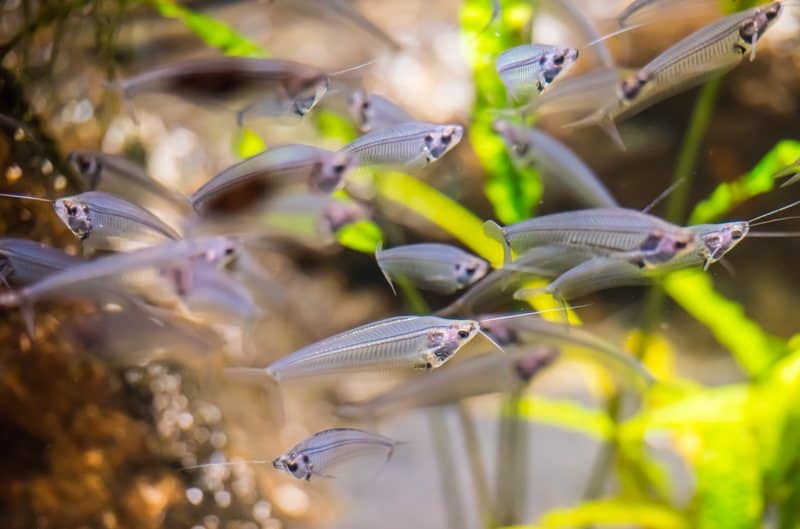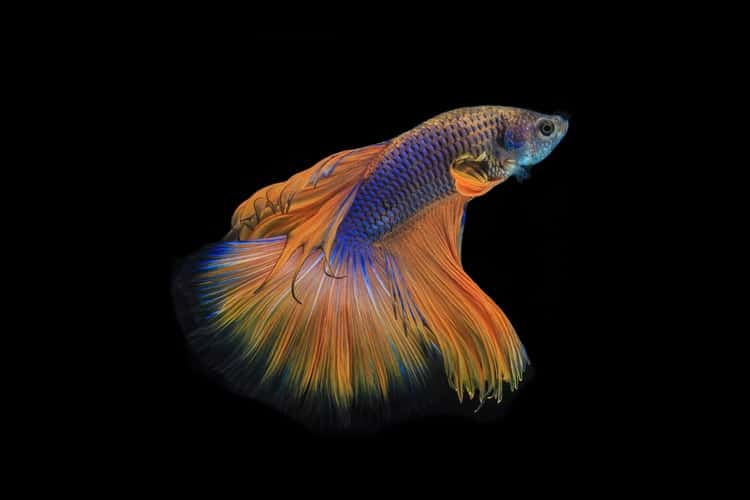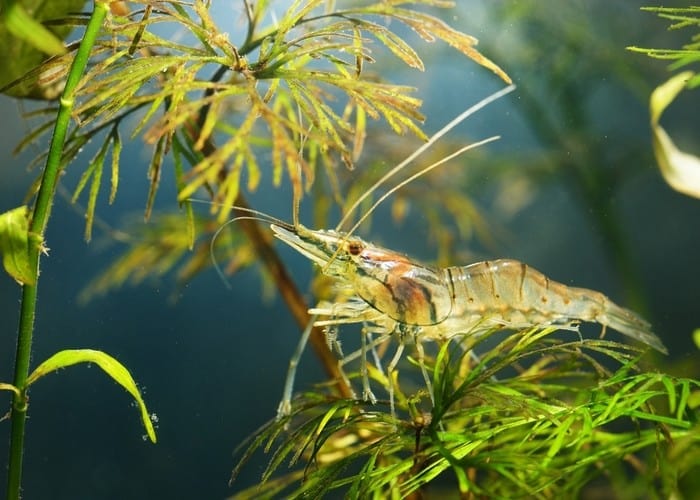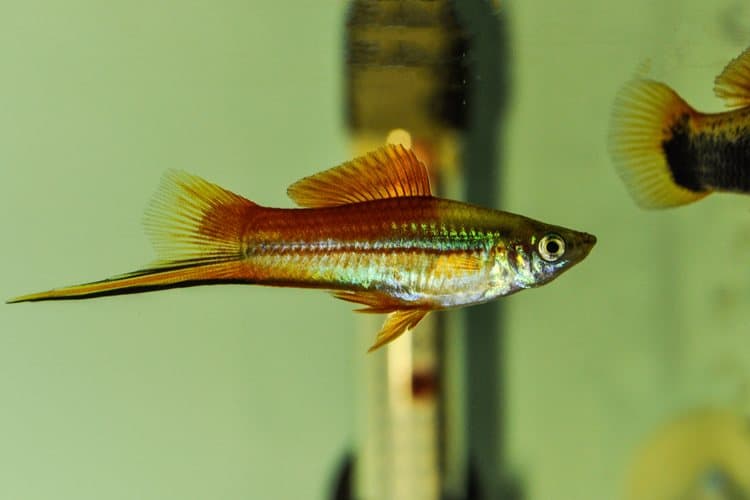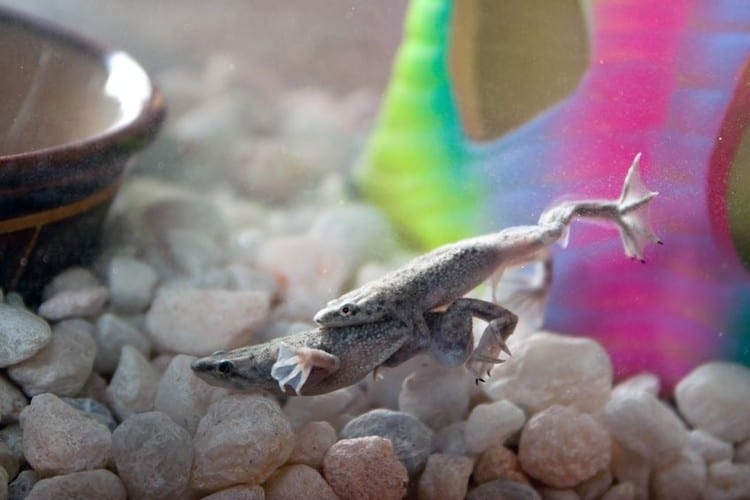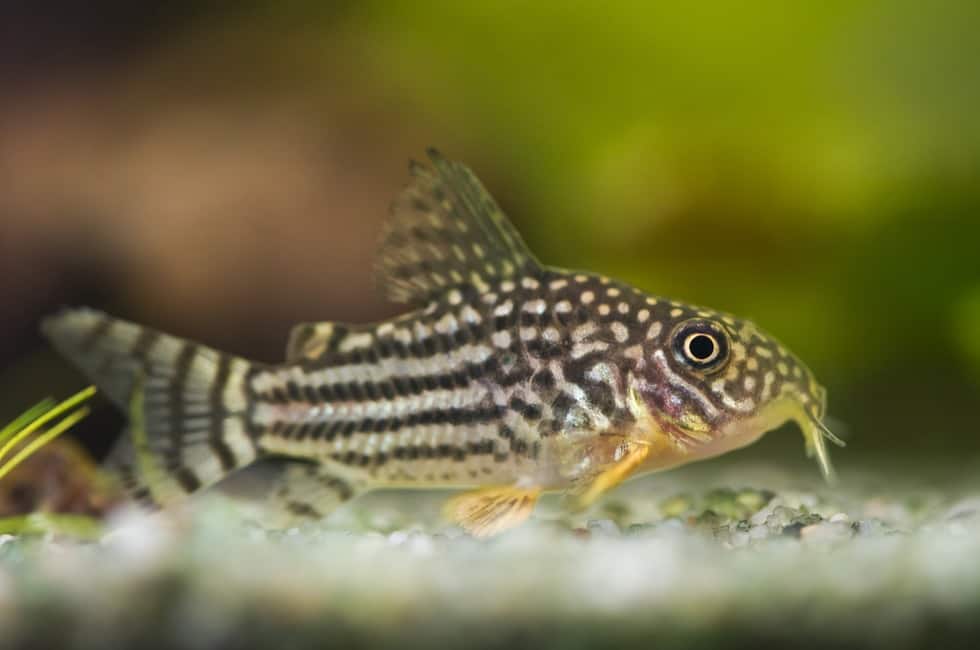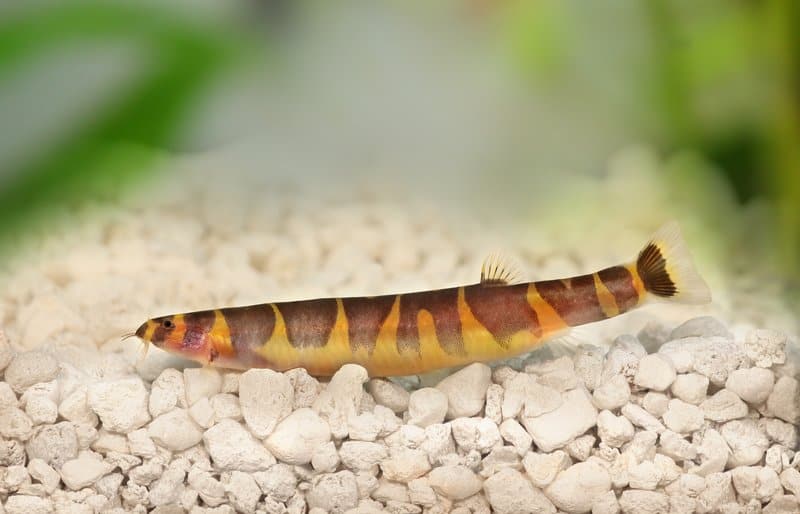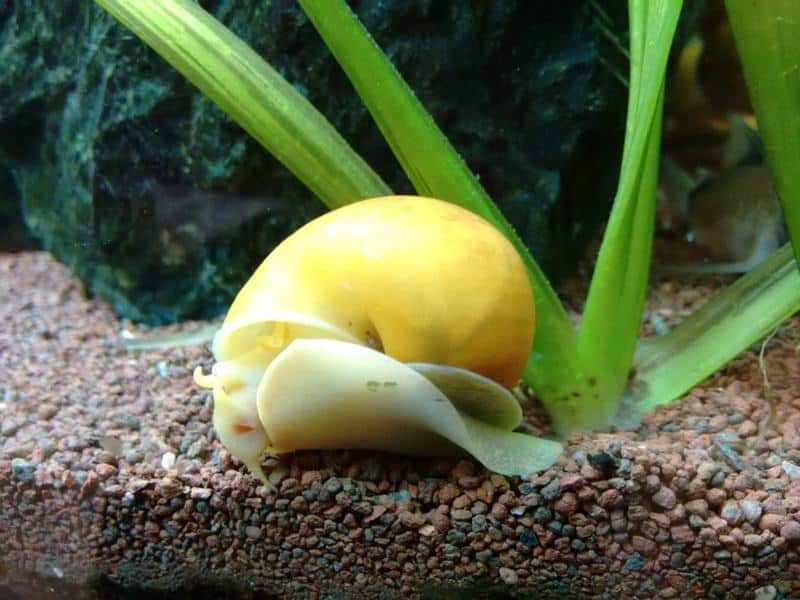Are you looking forward to adding some tank mates into a tank currently containing Neon Tetra? Well, you are in the right place. In this article, we will highlight some of the most compatible fish for your Neon Tetra.
But, first, let’s learn more about Neon Tetra.
What is a Neon Tetra?
The Neon Tetra is a freshwater fish native to South America. They were first discovered in the Amazon basin in 1934. Since then, they’ve become a favorite for most hobbyists. In fact, a whopping 2.5 million captive-bred Neon Tetras are sold each year in the USA.
Why do people love this fish?
It is partially due it is peaceful temperament and its radiant colors. Equally, the fact that it’s really easy to care for also contributes to its growing popularity. Overall, they are small, peaceful, schooling and nimble fish that spend much of their time in the middle of the water column.
Quick facts
- Family: Characidae
- Temperature: 21-27° C
- Adult size: 1.5 inches
- Tank size: 10+ gallons
- Ideal tank: freshwater, densely planted
- Diet: Omnivorous
- Lifespan: 8 years
- Care level: Easy
Fish that are the most compatible with Neon Tetra
1. Guppies
- Temperature: 23-29°C
- Adult size: 2.5 inches
- Tank size: 10+ gallons
- Diet: Omnivorous
- Lifespan: 2 years
- Care level: Easy
Guppies – A freshwater aquarium fish that is very easy to keep, Guppies prefer densely planted tanks with ample hiding places. These fish breed rapidly, and therefore if they are sharing a tank with the Neon Tetra, you should control their population. They are very active swimmers and males will chase females in a bid to impress them.
Interestingly, there are more than 300 varieties of guppies. Ensure that the tank is regularly cycled and kept under the optimal conditions such as a pH of 5.5-8.5. Guppies spend much of their time in the middle or at the surface of the tank.
2. Molly Fish
- Temperature: 22-26°C
- Adult size: 4 inches
- Tank size: 20+ gallons
- Diet: Omnivorous
- Lifespan: 5 years
- Care level: Easy
Molly fish comes in different varieties – White Molly, Black Molly, Sailfin Molly and many more. They are a staple of numerous tanks thanks to the fact that they are inexpensive, peaceful and easy to look after. For them to thrive, keep them in a 30-gallon and avoid overcrowding.
Although Mollies are hardy fish, we’d recommend a pH level of 7.0 to 8.0 and a temperature between 25 and 27°C. Also, ensure the tank has dense vegetation since they like scraping algae off these plants. Since they are omnivores, you can feed them with live or frozen food, commercial feeds, and vegetables. Just feed them two or three times a day.
3. White Cloud Mountain Minnow
- Temperature: 20-25°C
- Adult size: 1.5 inches
- Tank size: 10+ gallons
- Diet: Omnivorous
- Lifespan: 3-5 years
- Care level: Easy
These colorful, peaceful, nimble fish resemble the Neon Tetras, although they are not as expensive. They are a perfect start for novice hobbyists. In fact, they respond well to various water conditions but prefer cold to warm water. That said, keeping them in warm water might significantly reduce their lifespan.
As for the tank conditions, provide them with enough rocks, driftwood, and ample vegetation to mimic their natural habitat. Likewise, provide plenty of swimming space and subdued lighting to reveal their lavish colors.
White Cloud Minnows eat just about anything from live and frozen food, vegetables to commercial feeds. Feed them with mosquito larvae, shrimp or daphnia, and they will be happy.
4. Glass Catfish
- Temperature: 22-26°C
- Adult size: 5 inches
- Tank size: 30 gallons
- Diet: Omnivorous
- Lifespan: 8 years
- Care level: Moderate
Want to spice up your aquarium? Why not get this transparent fish? In fact, this feature alone explains why these peaceful fish have become common among hobbyists. They prefer a densely vegetated tank since it mimics their natural habitat.
You’ll find them in groups of 5-6 and unlike most catfish that prefer to stay at the bottom of the tank, you’ll find them swimming around. They are native to Thailand and prefer a water pH of 6.5 to 7.0.
They are prone to shock and therefore they don’t respond well to sudden fluctuations in water parameters. You can feed them with a wide array of food, but they prefer mosquito larvae, brine shrimps and bloodworms.
5. Betta fish
- Temperature: 22-26°C
- Adult size: 3 inches
- Tank size: 5 gallons
- Diet: Carnivorous
- Lifespan: 3 years
- Care level: Easy
Betta fish are peaceful fish that make a perfect tank mate for Neon Tetra. However, you should keep only one male per tank since they are very territorial. Bettas naturally gulp air from the water surface. Feed them twice a day, and although they are carnivores, you should supplement their diet with commercial foods.
Ensure that you keep water parameters at their recommended levels for optimal growth and survival. Also, the pH of the water should remain between 6.8 and 7.4. Keep your fish happy by introducing toys, kits, decorations and plenty of live plants.
6. Cardinal Tetra
- Temperature: 23-27°C
- Adult size: 2 inches
- Tank size: 20+ gallons
- Diet: Omnivorous
- Lifespan: 4 years
- Care level: Intermediate
Similar to Neon Tetras, Cardinal Tetras are peaceful, schooling fish that spend much of their time in small groups. Although harder to keep, they are still a favorite for many fish keepers. Their most ideal pH is below 6 and prefer 4 dGH water hardness.
Provide subdued light, ample live plants, decorations, and rocks. Also, ensure the water parameters are at said conditions. They are omnivores that require high vitamin food. As such, the diet should predominantly be made up of flakes.
7. Ghost Shrimp
- Temperature: 18-26°C
- Adult size: 1.5 inches
- Tank size: 10 gallons
- Diet: Omnivorous
- Lifespan: 1 year
- Care level: Easy
Do you want to keep your tank clean cheaply and naturally? Then settle for Ghost Shrimps. These freshwater crustaceans are kept by most hobbyists due to their ability to clean the tank. The shrimps should be kept in water pH level of 7.0 to 8.0. Also, ensure there are enough decorations and rocks where they can hide.
Dense vegetation is also essential since it provides them with areas to hide and is a source of food. Talking of food, they eat just about anything you throw at them, be it commercial food, live or vegetables. These peaceful buddies are excellent Neon Tetra tank mates.
8. Swordtail
- Temperature: 22-26°C
- Adult size: 4 inches
- Tank size: 10 gallons
- Diet: Omnivorous
- Lifespan: 3-5 years
- Care level: Easy
Swordtail fish are gradually becoming popular among hobbyists thanks to their peaceful nature, ease of care and radiant colors. In fact, most hobbyists refer to them as red swordtail. They prefer tanks with ample swimming space and since they are active jumpers, you ought to invest in a tank cover.
They thrive in slightly alkaline and hard water preferring water pH level between 7.0 and 8.5. Ensure the water stays under the stipulated temperature. They can feed on any type of food but predominantly prefer fruit flies, mosquito larvae, bloodworms, and brine shrimp.
9. African Dwarf Frog
- Temperature: 22-26°C
- Adult size: 1.25 inches
- Tank size: 10+ gallons
- Diet: Omnivorous
- Lifespan: 5 years
- Care level: Intermediate
African Dwarf Frogs makes a good tank mate for Neon Tetra given their peaceful nature and easy diet. These frogs are completely aquatic and also have lungs that let them breathe air from the water surface.
They are great lovers of bloodworms, sinking pellets and flakes. Feed them at least twice per day. The aquarium should have ample hiding places and you should invest in a lid since they are prone to jumping out of the tank. Overall, ensure you meet the required conditions for optimal growth and survival.
10. Plecos
- Temperature: 22-26°C
- Adult size: 24 inches
- Tank size: 30+ gallons
- Diet: Omnivorous
- Lifespan: 10-15 years
- Care level: Easy
Plecos are some of the most common fish that you can find in an aquarium. The most sort after Pleco is the common Pleco. These armored catfish are easy to care for and grow to a maximum size of 24 inches. Plecos are naturally algae eaters and, crucially, they will keep your tank clean.
That said, a diet with live or frozen bloodworms, brine shrimp or earthworms will do them just fine. Equally important are vegetables such as spinach and commercial food. That way your fish will splash around happy and fulfilled. Plecos are fairly hardy fish and will thrive at a pH level of 6.5 to 7.5. Also, ensure there are enough water currents.
11. Cory Catfish
- Temperature: 22-26°C
- Adult size: 2.5 inches
- Tank size: 10+ gallons
- Diet: Omnivorous
- Lifespan: 5 years
- Care level: Easy
Cory Catfish are natural bottom feeders that scavenge on leftovers found in the substrate. They are a preferred by a lot of hobbyists due to their peaceful temperament. Supplement their diet with vegetables, commercial food, and live or frozen meaty meals.
They tend to love tanks with ample hiding places and live plants that provide them with cover. They can adapt to a wide array of water conditions but tend to do well in established tanks. Again, ensure the water pH is between 7.0 and 7.8. Equally, power water conditions will significantly affect your Cory catfish.
12. Kuhli Loaches
- Temperature: 23-27°C
- Adult size: 4 inches
- Tank size: 20 gallons
- Diet: Omnivorous
- Lifespan: 10 years
- Care level: Intermediate
Although not so easy to care for, many hobbyists keep Kuhli Loaches due to their ability to keep the tank clean. They are natural scavengers that spend much of their time at the bottom of the tank. However, food waste should not be their staple food, so you should supplement this with flakes, pellets, veggies, and live and frozen foods.
Kuhli Loaches are very shy fish. In fact, you will rarely see them during the day. However, they are very active at night. They are very curious and prefer living in caves and tunnels. For optimal health, provide them with dense vegetation and lots of shade. Again, water pH should range between 5.5 and 6.5.
13. Apple Snails
- Temperature: 24-27°C
- Adult size: 3 inches
- Tank size: 10 gallons
- Diet: Omnivorous
- Lifespan: 1 year
- Care level: Easy
These popular aquarium snails are mostly referred to as Ivory Snails, Mystery Snails or Inca Snails. They are large and very bright. These snails are heavy feeders that feed on any leftover they find on the substrate. They are also rapid breeders and as such, you should control their population in a community tank.
They are particularly fond of live foods such as bloodworms and tubifex. However, you should also supplement their diet with sinking flakes and pellets. Again, ensure the bottom is of the tank clean for them to reach this food. An ideal tank should have ample rocks, decorations and live plants which also act as a source of food.
14. Halfbeak Fish
- Temperature: 22-26°C
- Adult size: 2.8 inches
- Tank size: 20+ gallons
- Diet: Carnivorous
- Lifespan: 9 years
- Care level: Easy
This is a fish that can add some uniqueness to your tank thanks to their unique jaw configuration. They are predominantly found in brackish warm waters. They tend to be duller than the Neon Tetra featuring a tan or brown coloration. They thrive in community tanks that have peaceful fish in them.
They prefer swimming at the top of the water column and thrive in densely vegetated aquariums with ample rocks and decoration. Again, provide a tight lid since they jump out of the tank. They should be fed on live and frozen meaty foods plus commercial feeds.
Which fish should not be kept together with Neon Tetra?
A Neon Tetra is not compatible with an aggressive or larger fish. So, which fish should you avoid? Let’s find out.
- Barbs
- Giant snakeheads
- Tigerfish
- Red-tailed black shark
- Giant Danio
These are some of the fish you should avoid keeping in a Neon Tetra community tank.
How should you set up a small community tank with Neon Tetra?
- Make sure the tank is clean. If newly bought, wash it with water and never use soap
- Add gravel into the tank and let it settle accordingly
- Add dechlorinated water up to almost half of the tank, then fill up with cycled aquarium water
- Place the heater in the tank, turn it on then add the filter
- Finally, add your LED light
- After a few hours add your preferred plants. We’d recommend Valisneria and some Anubias Nana. Also, add some decoration and driftwood
- Leave the tank for one week
- After one week, introduce your Neon Tetras. Ensure the tank has food in it.
Which are the best aquarium tanks for Neon Tetra?
- Aqueon 10 Gal LED Aquarium Kit: This 10-gallon tank is just the thing for a small Neon Tetra community tank. Comes with LED lights, powerful filter and crystal clear glass.
- Aqueon Fish Aquarium Starter Kits LED NeoGlow: This 10 gallon tank is ideal for novice hobbyists. It features a LED lighting system, heater, Aqueon LED Pro Filter and medium cartridge.
- Aqueon 15 Gallon LED Aquarium Kit: If you want a tall tank, then this is the right pick for you. Comes with a LED light system, fishnet, premium fish food, and water conditioner.
Which are the most ideal commercial feeds for neon tetra?
- API Fish Food Pellets: Comes loaded with nutrients for any community tank. In fact, it is rich in proteins. More nutrients, less waste!
- Hikari Micro Wafers for Pets: Do you want more colorful tetras? Then purchase these wafers; they contain Spirulina and Astaxanthin that promote coloration.
- SAN FRANCISCO BAY Brand Freeze Dried Bloodworms: Treat your Neon Tetras with some bloodworms. They are 52% protein.
Related Questions
What can I mix with Neon Tetras? There are numerous fish as mentioned above such as Bettas, small Catfish, Plecos and Guppies.
Can different types of Tetras live together? Yes, the Neon Tetra is compatible with the Cardinal Tetra
How many Neon Tetras should be kept together? At least 5-6.
What makes Tetras get aggressive? It naturally occurs when they are kept in a small tank. They get stressed and might attack other fish. They also get aggressive during breeding.
Are Neon Tetras fin nippers? Yes, they nip at each other’s fins. As such, it is recommended you keep them in groups of at least 6 to avoid nipping other tank mates.
Bottom-line
Neon Tetras are awesome community fish. Keep them with the right tank mates and they’ll surely thrive. Also, do not forget to feed them with Hikari Micro Wafers for Pets for optimal coloration.


